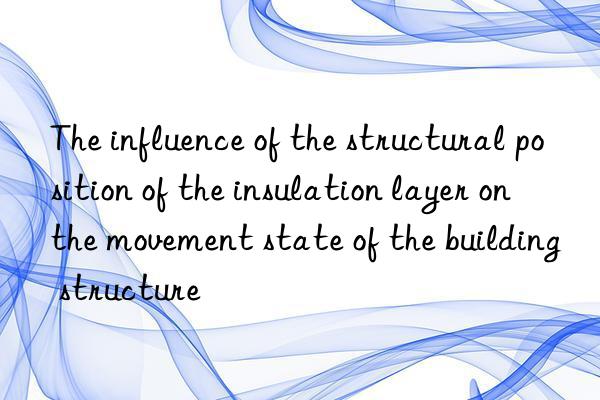
This article analyzes the influence of the structural position of the insulation layer on the motion state of the building structure; the technical route for flexible stress release; the difference in deformation speed is the main contradiction that causes hollowing, bulging, and cracking of the insulation layer; the gradual change layer by layer is to reduce the adjacent The main technical method for the poor thermal conductivity of materials; the phase change of water is an important factor in the destruction of the insulation layer, and the insulation layer must have the basic functions of water blocking and breathability; the lack of cavities is a stable wind-resistant structure; controlling the structural temperature is energy-saving Important means; research on fire protection grade evaluation standards and application scope.
1. The influence of the structural position of the insulation layer on the movement state of the building structure.
At present, the thermal insulation technologies for building envelope structures on the market mainly include external wall insulation, internal wall insulation, sandwich insulation and self-insulation.
1.1. Calculation of the influence of the structural position of the insulation layer on the temperature field of the building structure
Use the finite element and finite difference methods to establish the calculation of the temperature field of a typical insulation wall under conditions such as changes in external atmospheric temperature. Model, it can be seen that:
The external insulation system provides a stable temperature environment for the building structure, which not only ensures the insulation effect of the building, but also maintains the thermal stability of the structural system and extends the life of the building structure.
The external wall of the internal insulation system building structure is affected by the periodic ambient temperature, which increases the temperature difference between different structural parts, and the thermal stability of the building structure is poor;
Aerated concrete self-insulation The annual temperature difference on the outer surface of the system is large, and hollowing is likely to occur when high-strength plastering mortar is used.
Sandwich insulation creates a large temperature difference between the walls on both sides of the insulation layer. The insulation layer provides the worst thermal stability, which will shorten the life of the building structure.
1.2. The influence of the structural position of the insulation layer on the temperature stress of the building structure
When the overhanging parts are not insulated, thermal bridges will exist, causing local sharp changes in temperature stress and poor thermal stability of adjacent parts of the structure. .
The structural temperature changes and gradients of the externally insulated walls are small, and the temperature stress is also small. The structural temperature changes of the internally insulated walls are larger, the temperature gradient is also larger, and the temperature stress is larger. External insulation has a very good protective effect on the building structure.
The suspended structure without insulation, the temperature stress difference of the temperature and the unbeating site is increased, which affects the stability of the structure. The thermal insulation of this part should meet the requirements of structural stability.
Foreign insulation surfaces are mainly risked by tension stress and cracking. In summer, it is mainly subject to compressive stress and there is a risk of hollowing.
The insulation layer creates different temperature environments for the building, causing the stress state of the building to change. Choosing the correct insulation structure can extend the life of the building.
2. Technical route for flexible stress release
Based on the large temperature difference changes on the outer surface of the insulation layer, a technical route for flexible stress release is proposed.
The deformation setting of each structural layer of the thermal insulation system should generally meet the following requirements:
1. The deformation of the base concrete wall is 0.2‰ (temperature difference 20°C);
2. The deformation amount of the rubber powder polystyrene particle insulation slurry is 3‰;
3. The deformation amount of the anti-cracking protective layer is 5% to 7%;
4. The deformation amount of the flexible putty layer is 10% to 15%;
5. The deformation amount of the paint decorative layer is ≥150%.
3. The difference in deformation speed is the main contradiction that causes hollowing, bulging, and cracking of the insulation layer. The gradual change of thermal conductivity layer by layer is the main technical method to reduce the difference in thermal conductivity of adjacent materials.
When using XPS boards, the thermal conductivity differs by 31 times; during the project, uneven areas of the polystyrene board will be polished and leveled after pouring the polystyrene board, which will lead to uneven adhesion of the insulation layer and cause cracks on the wall surface.
After the cast polystyrene board is used, the rubber powder polystyrene particle insulation slurry is used to level the transition and the difference in thermal conductivity between adjacent materials is small, so it will not cause cracking.
Table 3.1 Relationship between thermal conductivity of insulation materials and polystyrene particle leveling layer
Insulation material | Thermal conductivity W/m·K | Insulation and anti-cracking thermal conductivity ratio | Polystyrene pellet leveling Layer thickness (mm) | Leveling and anti-cracking thermal conductivity ratio |
Expanded polystyrene board | 0.04 | 23 | ≥10 | 15 |
Extruded polystyrene board | 0.03 | 31 | ≥15 | 15 |
Polyurethane | 0.02 | 46.5 | ≥20 | 15 |



 微信扫一扫打赏
微信扫一扫打赏
